The Intel 9th Gen Review: Core i9-9900K, Core i7-9700K and Core i5-9600K Tested
by Ian Cutress on October 19, 2018 9:00 AM EST- Posted in
- CPUs
- Intel
- Coffee Lake
- 14++
- Core 9th Gen
- Core-S
- i9-9900K
- i7-9700K
- i5-9600K
CPU Performance: Encoding Tests
With the rise of streaming, vlogs, and video content as a whole, encoding and transcoding tests are becoming ever more important. Not only are more home users and gamers needing to convert video files into something more manageable, for streaming or archival purposes, but the servers that manage the output also manage around data and log files with compression and decompression. Our encoding tasks are focused around these important scenarios, with input from the community for the best implementation of real-world testing.
All of our benchmark results can also be found in our benchmark engine, Bench.
Handbrake 1.1.0: Streaming and Archival Video Transcoding
A popular open source tool, Handbrake is the anything-to-anything video conversion software that a number of people use as a reference point. The danger is always on version numbers and optimization, for example the latest versions of the software can take advantage of AVX-512 and OpenCL to accelerate certain types of transcoding and algorithms. The version we use here is a pure CPU play, with common transcoding variations.
We have split Handbrake up into several tests, using a Logitech C920 1080p60 native webcam recording (essentially a streamer recording), and convert them into two types of streaming formats and one for archival. The output settings used are:
- 720p60 at 6000 kbps constant bit rate, fast setting, high profile
- 1080p60 at 3500 kbps constant bit rate, faster setting, main profile
- 1080p60 HEVC at 3500 kbps variable bit rate, fast setting, main profile
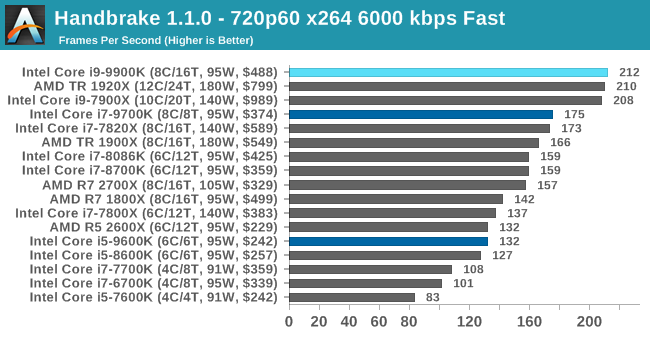
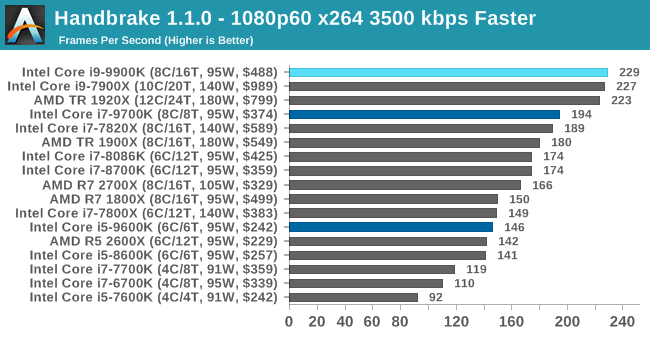
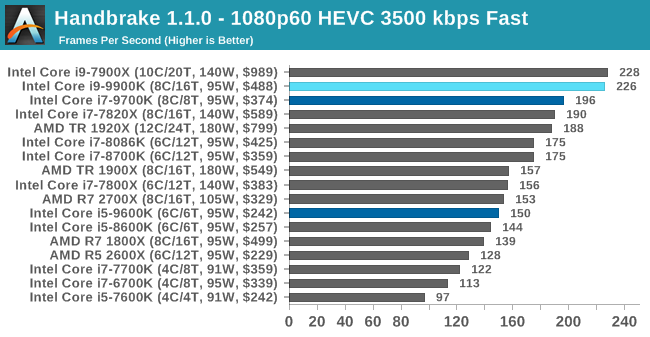
7-zip v1805: Popular Open-Source Encoding Engine
Out of our compression/decompression tool tests, 7-zip is the most requested and comes with a built-in benchmark. For our test suite, we’ve pulled the latest version of the software and we run the benchmark from the command line, reporting the compression, decompression, and a combined score.
It is noted in this benchmark that the latest multi-die processors have very bi-modal performance between compression and decompression, performing well in one and badly in the other. There are also discussions around how the Windows Scheduler is implementing every thread. As we get more results, it will be interesting to see how this plays out.
Please note, if you plan to share out the Compression graph, please include the Decompression one. Otherwise you’re only presenting half a picture.
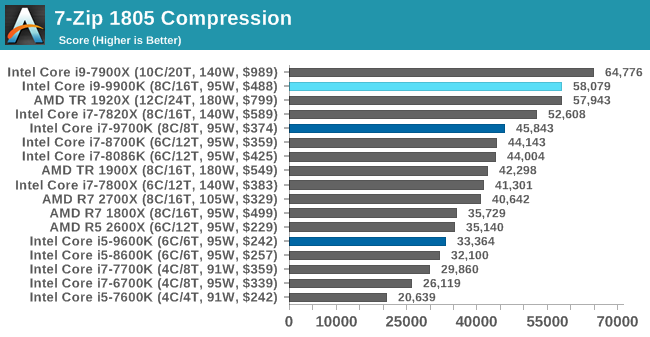
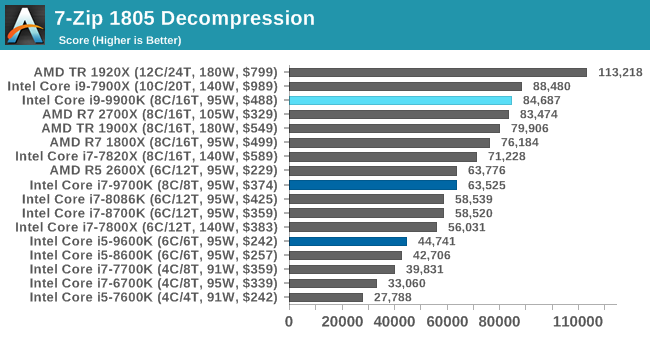
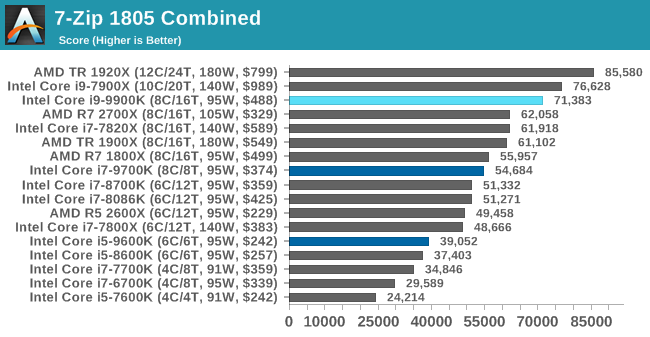
WinRAR 5.60b3: Archiving Tool
My compression tool of choice is often WinRAR, having been one of the first tools a number of my generation used over two decades ago. The interface has not changed much, although the integration with Windows right click commands is always a plus. It has no in-built test, so we run a compression over a set directory containing over thirty 60-second video files and 2000 small web-based files at a normal compression rate.
WinRAR is variable threaded but also susceptible to caching, so in our test we run it 10 times and take the average of the last five, leaving the test purely for raw CPU compute performance.
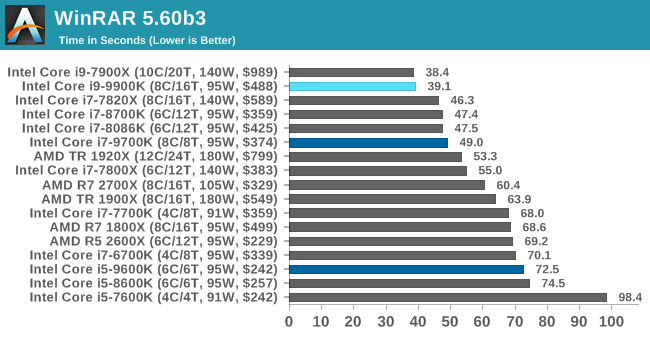
AES Encryption: File Security
A number of platforms, particularly mobile devices, are now offering encryption by default with file systems in order to protect the contents. Windows based devices have these options as well, often applied by BitLocker or third-party software. In our AES encryption test, we used the discontinued TrueCrypt for its built-in benchmark, which tests several encryption algorithms directly in memory.
The data we take for this test is the combined AES encrypt/decrypt performance, measured in gigabytes per second. The software does use AES commands for processors that offer hardware selection, however not AVX-512.
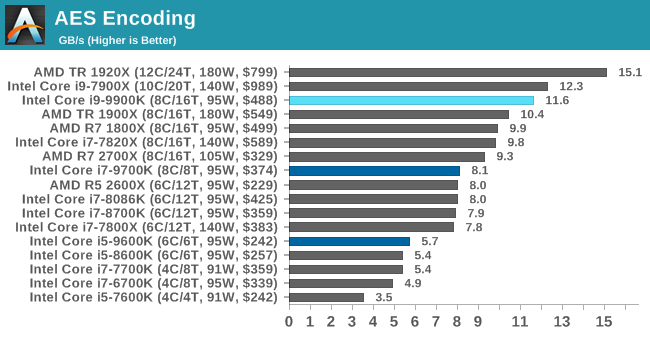










274 Comments
View All Comments
leexgx - Saturday, October 20, 2018 - link
Can you please stop your website playing silent audio, very annoying as it stops playback on my other phone (dual connection headset)moozooh - Sunday, October 21, 2018 - link
To be fair, the 9900K seems like a suboptimal choice for a gaming rig despite the claims—the extra performance is marginal and comes at a very heavy price. Consider that in all the CPU-bound 95th percentile graphs (which are the only important ones in this context)—even in the more CPU-intensive games—the 9700K was within 5% of the 9900K, sometimes noticeably faster (e.g. Civ6 Low). And its overclocking potential is just *so* much better—all of this at ~3/4 the price and power consumption (and hence more relaxed cooling requirements and lower noise). I cannot possibly envision a scenario where a rational choice, all this considered, would point to 9900K for a gaming machine. The at most 5% extra performance just isn't worth the downsides.On a sidenote, I'd actually like to see how an overclocked 9700K fares against overclocked 8700K/8086K (delidded for fair comparison—you seem to have had at least one of those, no?) with regards to frame times/worst performance. For my current home PC I chose a delidded 8350K running at 4.9 GHz on 1–2 cores and at 4.7 GHz on 3–4, which I considered the optimal choice for my typical usage, where the emphasis lies on non-RTS games, general/web/office performance, emulation, demoscene, some Avisynth—basically all of the tasks that heavily favor per-thread performance and don't scale well with HT. In most of the gaming tests the OC 8350K showed frame times about on par with the twice more expensive 8700K at stock settings, so it made perfect sense as a mid-tier gaming CPU. It appears that 9700K would be an optimal and safe drop-in replacement for it as it would double the number of cores while enabling even better per-thread performance without putting too much strain on the cooler. But then again I'd be probably better off waiting for its Ice Lake counterpart with full (?) hardware Spectre mitigation, which should result in a "free" minor performance bump if nothing else. At least assuming it will still use the same socket, which you never can tell with Intel...
R0H1T - Sunday, October 21, 2018 - link
Ryan & Ian, I see that the last few pages have included a note about Z390 used because the Z370 board was over-volting the chip? Yet on the Overclocking page we see the Z370 listed with max CPU package power at 168 Watts? Could you list the (default) auto voltage applied by the Asrock Z370 & if appropriate update the charts on OCing page with the Z390 as well?Total Meltdowner - Sunday, October 21, 2018 - link
Ryan, you do great work. Please don't let all these haters in the comments who constantly berate you over grammar and typos get you down.Icehawk - Saturday, October 27, 2018 - link
Ryan, I still haven't been able to find an answer to this - what are your actual HEVC settings? Because I've got an 8700 @4.5 no offset and it does 1080p at "1080p60 HEVC at 3500 kbps variable bit rate, fast setting, main profile" with passthrough audio and I get ~40fps not the 175 you achieved - how on earth are you getting over 4x the performance??? The only way I can get remotely close would be to use NVENC or QuickSync neither of which are acceptable to me.phinnvr6@gmail.com - Wednesday, October 31, 2018 - link
My thoughts are why would anyone recommend the 9900K over the 9700K? It's absurdly priced, draws an insane amount of power, and performs roughly identical.DanNeely - Friday, October 19, 2018 - link
Have any mobo makers published block diagrams for their Z390 boards? I'm wondering if the 10GB USB3.1 ports are using 2 HSIO lanes as speculated in the mobo preview article, or if Intel has 6 lanes that can run at 10gbps instead of the normal 8 so that they only need one lane each.repoman27 - Friday, October 19, 2018 - link
They absolutely do not use 2 HSIO lanes. That was a total brain fart in the other article. The datasheet for the other 300 series chipsets is available on ARK, and the HSIO configuration of the Z390 can easily be extrapolated from that.HSIO lanes are just external connections to differential signaling pairs that are connected internally to either various controllers or a PCIe switch via muxes. They’re analog interfaces connected to PHYs. They operate at whatever signaling rate and encoding scheme the selected PHY operates at. There is no logic to perform any type of channel bonding between the PCH and any connected ports or devices.
TEAMSWITCHER - Friday, October 19, 2018 - link
My big question ... Could there be an 8 core Mobile part on the way?Ryan Smith - Friday, October 19, 2018 - link
We don't have it plotted since we haven't taken enough samples for a good graph, but CFL-R is showing a pretty steep power/frequency curve towards the tail-end. That means power consumption drops by a lot just by backing off of the frequency a little.So while it's still more power-hungry than the 6-cores at the same frequencies, it's not out of the realm of possibility. Though base clocks (which are TDP guaranteed) will almost certainly have to drop to compensate.